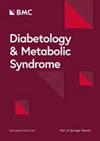摘要
1 型和 2 型糖尿病(T1D 和 T2D)都与骨骼健康状况不佳和成人骨折风险增加有关。然而,关于糖尿病对成长中的骨骼的影响,尤其是在青春期--骨矿物质增生的高峰期--的影响的数据却很有限。本研究的目的是检测骨健康标志物的差异,以及影响患有控制良好的 T1D 的白人青少年和年轻人(n = 17;平均 A1C 7.45 ± 1.15%)和未患 T1D 的对照组参与者(n = 13)骨健康的因素。两组患者的年龄相似(T1D 患者为 17.41 ± 1.62 岁,对照组为 17.46 ± 1.45 岁),体重指数和身高也相似。使用 GE HealthCare 的 Lunar iDXA(GE;v11-30.062)测量了所有受试者腰椎、全身和股骨近端部位的骨密度。在股骨近端进行了髋关节结构分析(HSA),并使用 Medimaps 公司的 Trabecular Osteo 软件根据 AP 脊椎图像计算了骨小梁评分(TBS)。对所有受试者的骨形成、骨吸收、血清硬骨素和尿液喷托苷的标志物进行了测量。在全身骨矿物质密度(BMD)、腰椎BMD、腰椎BMAD、双股骨BMD、HSA变量或TBS测量值方面,T1D受试者与对照组之间没有发现差异。不过,T1D 患者的糖尿病持续时间与横截面惯性矩(抗弯曲力的测量指标)呈显著负相关(p:0.035)。IGF-1水平在T1D组中略低(p:0.06),与平均髋轴角呈显著反向关系(r:-0.406,p:0.026);髋轴角是已知的髋部骨折预测因子。在对年龄进行调整后,TBS评分与两组的尿戊苷(胶原糖基化的标志物)呈略微显著的负相关(r:-0.343,p:0.07),这表明胶原糖基化的增加会对骨的微观结构产生不利影响。临床试验编号:不适用。Both type 1 and type 2 diabetes mellitus (T1D and T2D) are associated with poor bone health and an increased risk of fracture in adults. However, there are limited data regarding the effects of diabetes on the growing skeleton, particularly during adolescence, the time of peak bone mineral accretion. The purpose of this study was to examine differences in markers of bone health and factors that influence bone health in White adolescents and young adults with well-controlled T1D (n = 17; Average A1C 7.45 ± 1.15%) and control participants without T1D (n = 13). Age across both groups was similar (17.41 ± 1.62 years for T1D vs. 17.46 ± 1.45 years for controls) as was BMI and height. Bone density was measured at the lumbar spine, whole body, and proximal femur sites using the GE HealthCare's Lunar iDXA (GE; v11-30.062) in all subjects. Hip structural analysis (HSA) was performed at the proximal femur and Trabecular Bone Score (TBS) was calculated from AP spine image using Trabecular Osteo Software from Medimaps. Markers of bone formation, resorption, serum sclerostin and urine pentosidine were measured in all subjects. No difference in total body bone mineral density (BMD), lumbar spine BMD, lumbar spine BMAD, dual femur BMD, HSA variables or TBS measures were noted between subjects with T1D and controls. However, duration of diabetes had a significant negative correlation (p: 0.035) with cross-sectional moment of inertia (a measure of resistance to bending forces) in subjects with T1D. IGF-1 levels were marginally lower in the group with T1D (p:0.06) and had a significant inverse relationship (r: -0.406, p:0.026) with mean hip axis angle; a known predictor of hip fractures. TBS score had a marginally significant negative correlation with urinary pentosidine (a marker for collagen glycosylation) across both groups after adjusting for age (r: -0.343, p: 0.07), suggesting increased collagen glycosylation has an adverse impact on bone microarchitecture. CLINICAL TRIAL NUMBER: Not applicable.

 求助内容:
求助内容: 应助结果提醒方式:
应助结果提醒方式:


